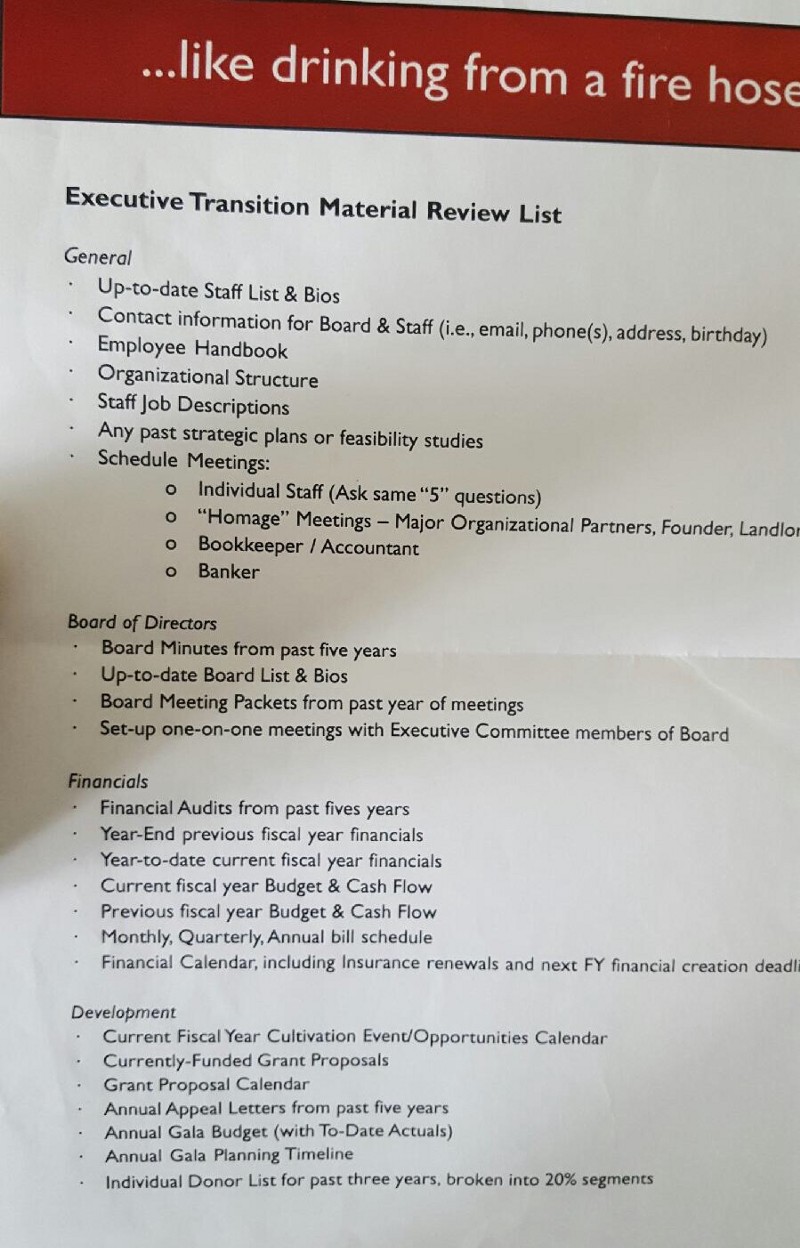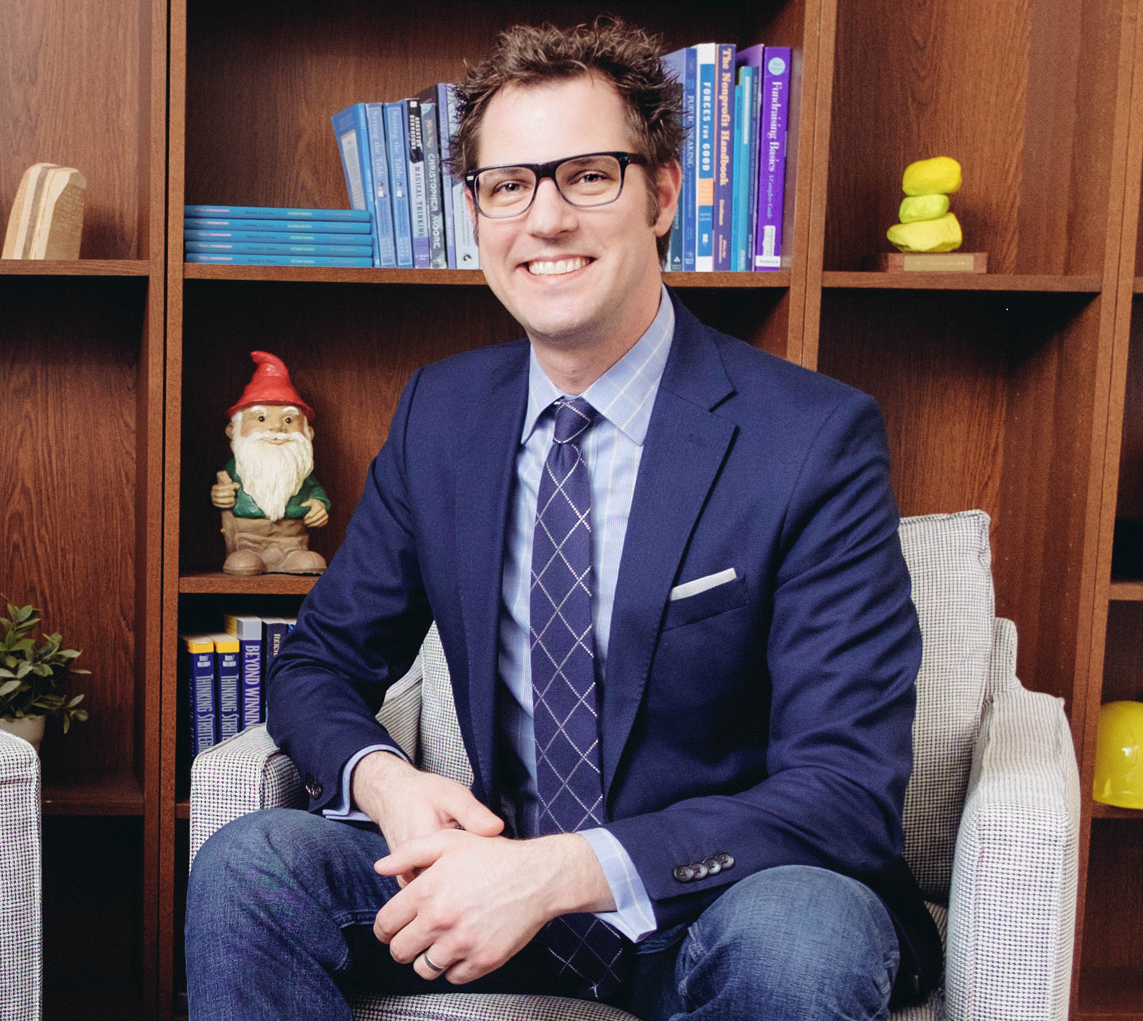…like drinking from a fire hose
Big Ideas | How We Work | People Operations | Human Resources

Pre-gaming your arrival to the executive director’s chair
It was like receiving an electronic time capsule from my younger self when the text message pinged its arrival. Last week a friend texted me the photo below of a handout I created to accompany a talk I gave about ten years ago. I don’t recall the session name, but the handout was titled, “…like drinking from a fire hose,” and contained a list of the things I suggested a new non-profit executive director review before sitting down in that fancy, new chair on their first day.
 Time capsule… in handout format.
Time capsule… in handout format.I remember explaining how sliding into that executive director chair, particularly at a new or unfamiliar organization, can feel a lot like you’re drinking from a fire hose. There’s so much information flying at you — so much signal and noise — you can struggle to make sense of it all. Pre-gaming before you actually sit down on the first day can help you get the lay of the land before being inundated with the daily battle of the urgent versus the important.
You’ll never see the organization as clearly as you do on the morning of your first day.
So thanks to my friend — who found the handout while packing to move on to her newest gig as an Executive Director (poetic, right?) — I am able to recycle the list and share it with you here.
As I scrolled through the list I thought, would I still ask for the same things? What did I think each item told me? Does the knowledge gleaned from each still carry the same weight? What would leaders I admire include on their lists or would they approach this in a totally different way?
In the end, if I were moving into the executive chair at a new organization, I think I would ask for much of the same material to review. That said, one item in particular would carry more weight for Tim Cynova circa 2016 than Tim Cynova of yesteryear:
“Schedule meetings: Individual Staff (Ask same 5 questions).”
Understanding the team, listening to them explain from their perspective the organization’s — and their own — strengths and weaknesses can yield a great deal of helpful intel. Do they hint at a toxic work environment that burns through staff? Do they use an internal locus of control or an external locus of control to describe the organization (i.e., “what can we do right now to move towards what we really want” versus “there’s nothing we can do, bad stuff just keeps happening to us”)? Do they talk about their coworkers and the work in glowing terms with everyone working towards the same purpose? Do they talk about all coming together to find solutions to significant challenges, or do they talk in terms of going it alone? Does accurate information freely flow throughout the organization, or do only a few people seem to know what’s going on?
It’s not likely that you’ll land in a place where all of the answers to these questions are positive. That okay, that’s part of the challenge. This is a fact-finding mission. You need to know what you’re working with in order to know how to approach it.
In order to play the hand you’re dealt to the best of your ability, you better first look at the cards.
Research (and experience) shows that “B” talent who function as a cohesive team outperform “A” players who struggle to coalesce as a group. No organization is perfect, even the seemingly “top flight” companies have their challenges. Assessing, adjusting, and developing your team so everyone is working together towards a common purpose is arguably the most important part of the executive director’s job. How else are they expected to achieve all of the other goals?
Tim Cynova circa 2016 walking into an unfamiliar organization wants to understand the people. What gets them up in the morning. Why do they come to work every day. What do they see as their role in the organization and on their respective teams. In their wildest dreams what does success look like and what do they need to achieve it. Without understanding these things you could set a course without knowing if you have the right people to help you get there.
I wish my friend the best in her new role. Not that she needs it. She’s already a talented leader who has accomplished exciting things in her career. But I do appreciate her for texting me that time capsule from the past.
What’s on your “drinking from a fire hose” list?
About Tim Cynova
Tim wears a multitude of hats, all in service of creating anti-racist workplaces where people can thrive. He currently is co-CEO of Fractured Atlas (an entirely virtual organization with staff spread across multiple states and countries) and a Principal of the consulting group Work. Shouldn't. Suck. He serves on the faculty of Banff Centre for Arts & Creativity and The New School teaching courses in People-Centric Organizational Design; he's a trained mediator, and a certified Senior Professional in Human Resources (SPHR). Earlier in his career, Tim was the Executive Director of The Parsons Dance Company and of High 5 Tickets to the Arts in New York City, had a memorable stint with the Cincinnati Symphony Orchestra, was a one-time classical trombonist, musicologist, and for five years in his youth he delivered newspapers for the Evansville, Indiana Courier-Press. Also, during a particularly slow summer, he bicycled 3,902 miles across the United States.


